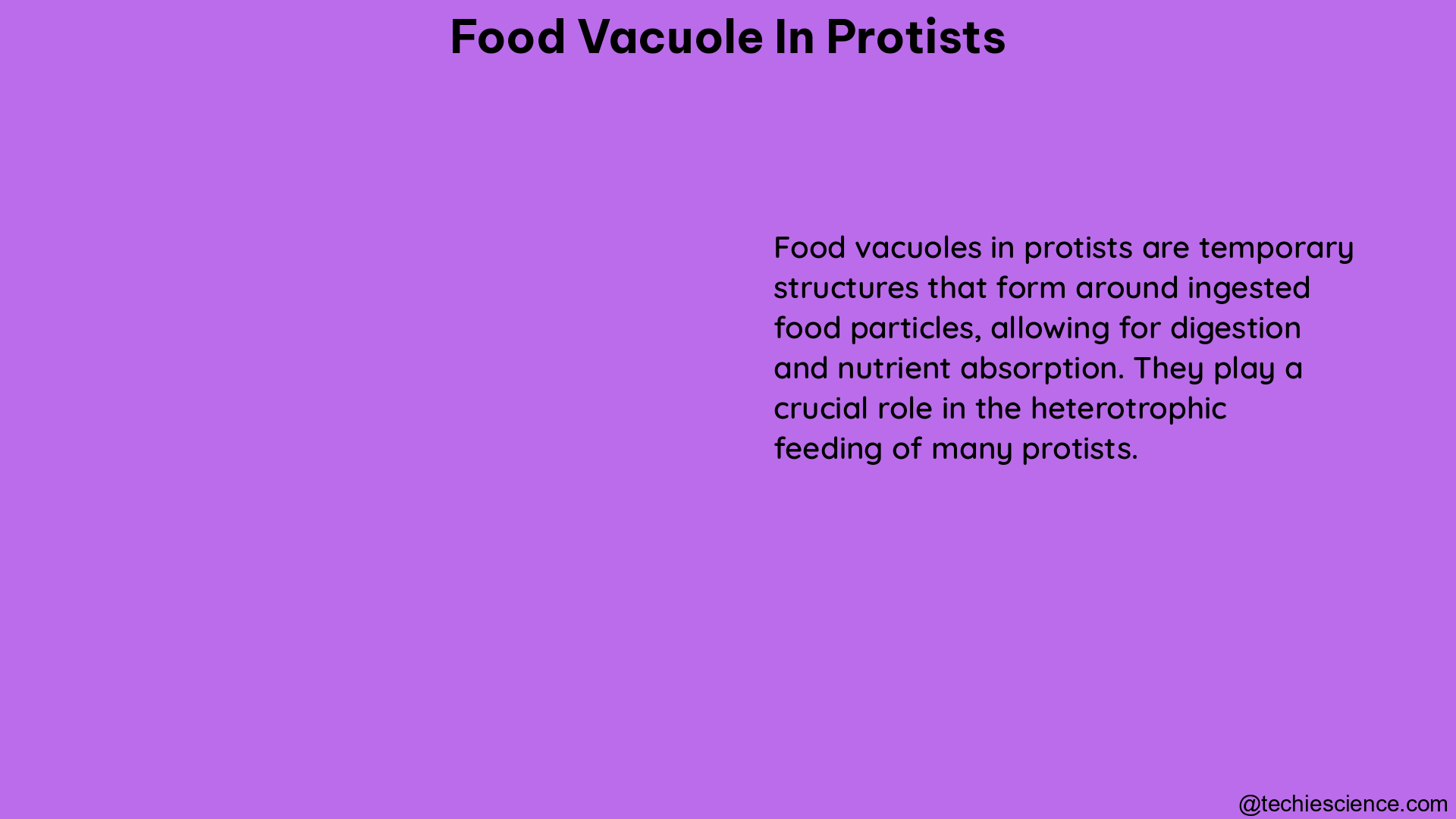Food vacuoles are membrane-bound organelles found in protists, playing a crucial role in the digestion and processing of food. These specialized structures are formed through a process called phagocytosis, where the cell membrane engulfs food particles and pinches off to create a separate vacuole. The size, number, and volume of food vacuoles can vary significantly depending on the species of protist and its nutritional status.
Understanding the Dimensions of Food Vacuoles
In the ciliate protozoan Tetrahymena pyriformis, the average diameter of newly-formed food vacuoles is typically between 5-6 μm, with a lower limit of approximately 1 μm. This size range is essential for the efficient digestion and processing of various food particles. Interestingly, the number of food vacuoles per cell can range from 15-17 in cells growing exponentially in a chemically defined medium.
To further quantify the role of food vacuoles, researchers have measured the total volume of these structures formed during a generation time. In Tetrahymena pyriformis, the total volume of food vacuoles formed in a generation time has been found to be approximately 150 μm³. Additionally, the area of the food vacuole membranes has been estimated to be around 151 μm², providing insights into the surface area available for various cellular processes.
Correlation between Food Vacuole Size and Feeding Activity

In the well-studied ciliate Paramecium, the size of food vacuoles has been found to be correlated with the quantitative rate of ingestion under certain conditions. This observation suggests that the size of the food vacuole may serve as an indicator of the feeding activity of the protist. By monitoring the size of food vacuoles, researchers can gain valuable insights into the feeding patterns and nutritional status of these unicellular organisms.
Environmental Factors Influencing Food Vacuole Formation
The formation of food vacuoles in protists can be influenced by various environmental factors, including the salinity of the surrounding medium. In the ciliate Tetrahymena thermophila, the rate of food vacuole formation has been observed to be affected by changes in salinity.
This phenomenon can be attributed to the fact that alterations in salinity can impact the osmotic balance of the cell, which in turn can influence the formation and dynamics of food vacuoles. By understanding the relationship between environmental factors and food vacuole formation, researchers can better understand the adaptability and survival strategies of protists in diverse ecological niches.
Quantifying Food Vacuole Dynamics
The size, number, and volume of food vacuoles in protists can be measured and quantified using various microscopic and analytical techniques. These measurements provide valuable insights into the feeding and digestive processes of these unicellular organisms.
For instance, in Tetrahymena pyriformis, the average diameter of newly-formed food vacuoles has been found to be 5-6 μm, with a lower limit of approximately 1 μm. The number of food vacuoles per cell can range from 15-17 in cells growing exponentially in a chemically defined medium. The total volume of food vacuoles formed in a generation time has been measured to be approximately 150 μm³, and the area of the food vacuole membranes has been estimated to be around 151 μm².
Similarly, in Paramecium, the size of food vacuoles has been correlated with the quantitative rate of ingestion, suggesting that the size of the food vacuole can serve as an indicator of the feeding activity of the protist.
Factors Influencing Food Vacuole Formation
The formation of food vacuoles in protists can be influenced by various environmental and physiological factors. One such factor is the salinity of the surrounding medium, as observed in the ciliate Tetrahymena thermophila.
Changes in salinity can affect the osmotic balance of the cell, which in turn can impact the formation and dynamics of food vacuoles. This relationship highlights the adaptability of protists to their environmental conditions and the importance of understanding the interplay between external factors and the internal processes of these unicellular organisms.
Significance of Food Vacuole Studies
The study of food vacuoles in protists holds significant importance in various fields of biology and biotechnology. By understanding the size, number, and volume of these organelles, researchers can gain insights into the feeding and digestive processes of protists, which can have implications for:
-
Ecological studies: Analyzing the food vacuole dynamics of protists can provide valuable information about their role in nutrient cycling and energy flow within ecosystems.
-
Biotechnological applications: The knowledge of food vacuole formation and function can be leveraged in the development of novel bioprocessing techniques, such as the production of valuable biomolecules or the bioremediation of environmental pollutants.
-
Evolutionary biology: Comparative studies of food vacuole characteristics across different protist species can contribute to our understanding of the evolutionary adaptations and diversification of these unicellular organisms.
-
Cellular and molecular biology: Investigating the mechanisms underlying the formation, function, and regulation of food vacuoles can shed light on the fundamental cellular processes in protists, which may have broader implications for eukaryotic biology.
Conclusion
Food vacuoles in protists are fascinating and complex organelles that play a crucial role in the digestion and processing of food. By studying the size, number, and volume of these structures, researchers can gain valuable insights into the feeding and nutritional dynamics of these unicellular organisms. Understanding the factors that influence food vacuole formation, such as environmental conditions, can also provide insights into the adaptability and survival strategies of protists in diverse ecological niches. The significance of food vacuole studies extends beyond the realm of protistology, with potential applications in fields ranging from ecology and biotechnology to evolutionary biology and cellular biology.
References:
- Rasmussen, L. (1973). Nutrient uptake in Tetrahymena pyriformis. Archiv für Mikrobiologie, 93(2), 115-126. https://link.springer.com/content/pdf/10.1007/BF02906539.pdf
- The Food-Vacuole in Paramecium. (1937). The American Naturalist, 71(733), 157-166. https://www.jstor.org/stable/2457967
- Effect of salinity on food vacuole formation in T. thermophila. (2018). Expedition, 40(1). https://ojs.library.ubc.ca/index.php/expedition/article/view/193463/189816
- How Are Food Vacuoles Formed In Protists? (n.d.). BYJU’S. https://byjus.com/question-answer/how-are-food-vacuoles-formed-in-protists/

Hi….I am Anushree Verma, I have completed my Master’s in Biotechnology. I am a very confident, dedicated and enthusiastic author from the biotechnology field. I have a good understanding of life sciences and great command over communication skills. I thrive to learn new things every day. I would like to thank this esteemed organization for giving me such a great opportunity.
Let’s connect through LinkedIn- https://www.linkedin.com/in/anushree-verma-066ba7153